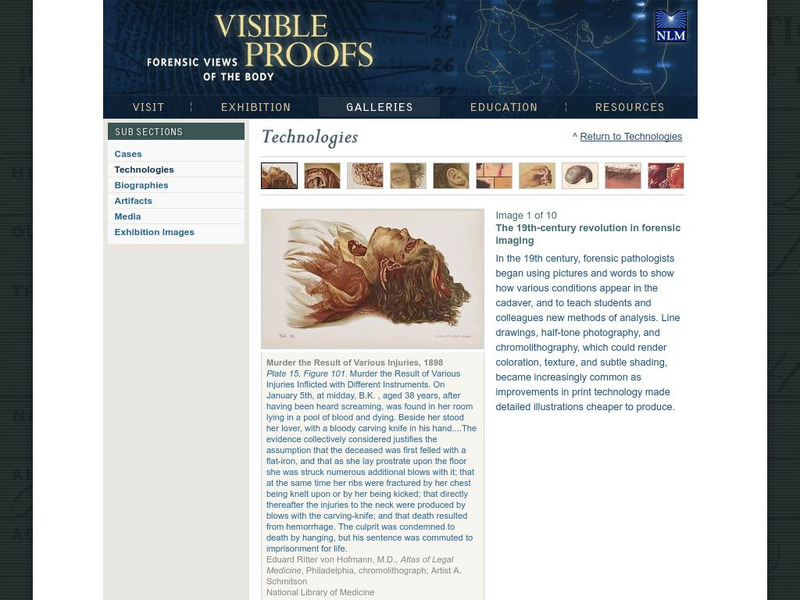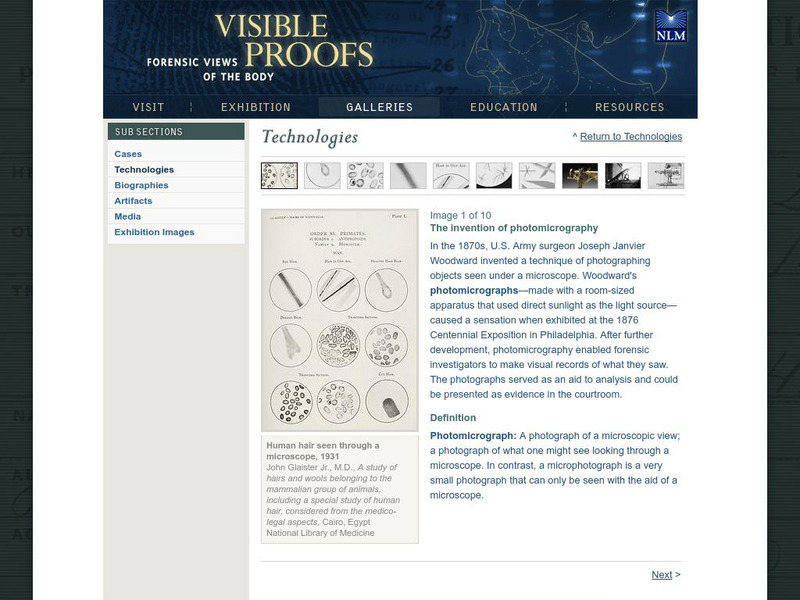Intel
Forensics: Get a Clue
Although the methods are all scientific, forensic science was started by police officers rather than scientists, who relied on observation and common sense. Young detectives use many tools to solve crimes around the school in a...
Columbus City Schools
Thinking Like A Soil Scientist
Ready to roll up those sleeves and get your hands dirty? Dirty with soil science content, that is! Overcome those "But it's just dirt" objections with a trip outside to collect soil samples for some in-class analysis. Use the...
Kenan Fellows
Unit 2: DNA Analysis
Ever wonder how they solve those mysterious murders in TV crime dramas? The second of four units in a Biotechnology series introduces scholars to the many methods of DNA analysis. Pupils create and run their own gel electrophoresis...
Georgia Department of Education
Ga Virtual Learning: Forensic Science
In this comprehensive learning tutorial you will be provided with a brief introduction to Forensic Science and the history of Forensic Science. You will explain the different specialty areas of a forensic laboratory and discuss the...
Virtual Museum of Canada
Virtual Museum of Canada: Virtual Exhibit on Forensic Science
Discover the components of forensic science. There is also a link to a simulation in which you can apply your skills to solve a crime.
TED Talks
Ted: Ted Ed: Early Forensics and Crime Solving Chemists
In a CSI age, we take forensic science for granted. New York did not have a medical examiner or forensic toxicologist until 1918, whose eventual arrival changed the landscape of crime investigation forever. Deborah Blum prompts the TED...
National Institutes of Health
National Library of Medicine: The 19th Century Revolution in Forensic Imaging
In the 19th century, forensic pathologists began to use words and pictures to describe cadavers and to teach using cadavers in the classroom. See a number of interesting photos of various crime scenes on this interesting site.
National Institutes of Health
National Library of Medicine: Virtopsy, the Virtual Autopsy
An interesting site that delves into how forensic scientists perform minimally invasive autopsies using state of the art technology.
National Institutes of Health
National Library of Medicine: Spectral Detection
This concise site provides a brief discussion of the invention of the first work spectroscopes and their impact on forensic science.
National Institutes of Health
National Library of Medicine: Reading Gunshot Patterns
Various pictures of parts of the human anatomy showing gun shot trauma are found on this interesting site. .
National Institutes of Health
National Library of Medicine: The Bertillon System
Bertillon devised a system to make order out of the myriad of crime scene photos taken by the police. This brief site describes how that system worked and shows a number of crime scene photos taken from Bertillon's photo album.
National Institutes of Health
National Library of Medicine: Key Accomplishments, Dna
A brief history of the major discoveries related to DNA from 1865 until 1991. Pictures of the responsible reponsibile for these key accomplishments are included as well.
National Institutes of Health
National Library of Medicine: Entomology in Action
Two lesson plans are found in this site. Lesson Plan 1 is geared to grades 6-9. In this plan, student's will be able to list the different stages of the blow fly's life cycle and understand how the life cycle and ADH (accumulated degree...
National Institutes of Health
National Library of Medicine: Dna a Molecular Identity
In this lesson plan site, students learn about DNA and examine three different situations where DNA was used to solve a case.
National Institutes of Health
National Library of Medicine: The Invention of Photomicrography
The technique of photographing objects observed under a microscope is discussed in this succinct site. Various pictures taken under a microscope are displayed on this site as well.
National Institutes of Health
National Library of Medicine: The Marsh Test
The Marsh Test, developed in 1832, was designed to detect poison in drinks. A short history of this test is provided along with photo of the test apparatus.
National Institutes of Health
National Library of Medicine: Key Accomplishments, Radiology
A history of radiology is featured from 1901 until 2003. Succinct paragraphs cover the highlights of each discvery.
National Institutes of Health
National Library of Medicine: Key Accomplishments, Toxicology
The history of toxicology is discussed from 1702 through 1966. Explanations of major discoveries are brief and to the point.

















